AL-QAIDA BEGINS ITS FIGHT AGAINST AMERICA IN SOMALIA
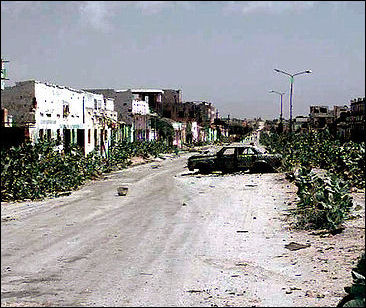
Mogadishu 1993 Peter Bergen wrote in the Wall Street Journal: “In the unipolar world of the 1990s, al Qaeda's leaders believed that they had only one force standing in their way — "the far enemy," the U.S. While bin Laden was based in Sudan in the early and mid-1990s, al Qaeda slowly became operational -- sending men to Somalia, for instance, to fight U.S. forces stationed in the country. It was at the tail end of al Qaeda's sojourn in Sudan in 1996 that U.S. counter-terrorism officials got their first big break. Jamal al Fadl, an early member of the group, defected. His debriefer was Daniel Coleman, Mr. Wright says, a "scholarly and inquisitive" FBI agent who "concluded that al Qaeda was a world-wide terrorist organization dedicated to destroying America."
Lawrence Wright wrote in The New Yorker: “In 1993, bin Laden dispatched Mohamed Atef to Somalia to look for ways of attacking the American military forces that were participating in an international famine-relief effort. Bin Laden gloried in the fact that his men had trained the Somali militiamen who shot down two American helicopters in the "Black Hawk Down" incident, in October of that year, prompting President Clinton to withdraw all American soldiers from the country. "Based on the reports we received from our brothers in Somalia," bin Laden said, "we learned that they saw the weakness, frailty, and cowardice of U.S. troops. Only eighteen U.S. troops were killed. Nonetheless, they fled in the heart of darkness.” [Source: Lawrence Wright, The New Yorker, September 16, 2002]
In October 1993, 18 American service members were killed in Somalia while on a peacekeeping mission. Some of their bodies were dragged through the streets. Bin Laden was overjoyed by the success of his activities in Somalia. After leaving Afghanistan, the Muslim fighters headed for Somalia and prepared for a long battle, thinking that the Americans were “like the Russians,” he told an interviewer. “The youth were surprised at the low morale of the American soldiers and realized more than before that the American soldier was a paper tiger and after a few blows ran in defeat,” he said. “And America forgot all the hoopla and media propaganda about being the world leader and the leader of the new world order, and after a few blows, they forgot about this title and left, dragging their corpses and their shameful defeat.” [Source: Kate Zernike and Michael T. Kaufman, New York Times, May 2, 2011]
Kate Zernike and Michael T. Kaufman wrote in the New York Times: Within Al Qaeda, bin Laden “argued that the organization should put aside its differences with Shiite terrorist groups like Hezbollah in Lebanon, the better to concentrate on the common enemy: the United States. He called for attacks against American forces in the Saudi peninsula and in the Horn of Africa.
Early Al-Qaida Terrorist Acts

Black Hawk Down Kate Zernike and Michael T. Kaufman wrote in the New York Times: “On Dec. 29, 1992, a bomb exploded in a hotel in Aden, Yemen, where American troops had been staying while on their way to Somalia. The troops had already left, and the bomb killed two Austrian tourists. American intelligence officials came to believe that it was Bin Laden’s first attack...”On Feb. 26, 1993, a bomb exploded in a truck driven into the underground garage at the World Trade Center, killing six people. Bin Laden later praised Ramzi Yousef, who was convicted of the bombing. [Source: Kate Zernike and Michael T. Kaufman, New York Times, May 2, 2011]
“By 1994, Bin Laden had established new training camps in Sudan, but he became a man without a country. The Saudi government froze his assets and revoked his citizenship. His family, which had become rich on its relations with the royal family, denounced him publicly after he was caught smuggling weapons from Yemen. This seemed to make him only more zealous. He sent an open letter to King Fahd outlining the sins of the Saudi government and calling for a campaign of guerrilla attacks to drive Americans from Saudi Arabia.
“Three months later, in November 1995, a truck bomb exploded at a Saudi National Guard training center operated by the United States in Riyadh, killing seven people. That year, Belgian investigators found a kind of how-to manual for terrorists on a CD. The preface dedicated it to Bin Laden, the hero of the holy war. The next May, when the men accused of the Riyadh bombing were beheaded in Riyadh’s main square, they were forced to read a confession in which they acknowledged the connection to Bin Laden. The next month, June 1996, a truck bomb destroyed Khobar Towers, an American military residence in Dhahran. It killed 19 soldiers.”
Lawrence Wright wrote in The New Yorker: Emboldened by the success of the "Black Hawk Down" incident in Somalia, bin Laden escalated his campaign against America. In November of 1995, Al Qaeda bombed the National Guard communications center, in Riyadh, where American troops were training Saudis in surveillance methods. Five Americans were killed. Al Qaeda struck again in June of 1996, with a bombing at the Khobar Towers dormitory, in Dharan, Saudi Arabia, which killed nineteen American servicemen. (U.S. intelligence officials suspected that Iranian extremists were responsible, but they subsequently learned that Zawahiri called bin Laden immediately afterward to congratulate him on the operation.) Bin Laden declined to take credit,[Source: Lawrence Wright, The New Yorker, September 16, 2002]
Riyadh Bombing in 1995

Khobar Tower On November 13, 1995, seven people were killed and 60 were injured in Riyadh, Saudi Arabia when a car bomb exploded in front of a building of the Saudi National Guard where US military advisers worked. Five of the seven people killed were Americans. The two others were Indians. One American survivor told Newsweek, “It was almost as if I had been electrocuted. I fainted and seconds later I started hearing people screaming.” The cafeteria where she was was “completely covered in dust and blood.” It was the first car bomb attack ever in Saudi Arabia.
A group called The Islamic Movement of Change took credit for the attack. The attack shattered illusions that Saudi Arabia was immune from terrorist attacks. Four Saudis, described by the Saudi government as anti-royal dissidents, were arrested and confessed on television. They said they were “inspired” by Osama bin Laden and were beheaded before American officials had a chance to interrogate them.
Khobar Towers Bombing in 1996
On June 25, 1996, a massive truck bomb exploded outside Khobar Towers, an apartment complex used to house American airmen, at a US military base in Dhahran, in Saudi Arabia, killing 19 American nationals and wounding 386 others. The explosives were in a fuel tanker truck that pulled up to a wall by the apartment. The men in the truck jumped out and hopped in a white car that sped off. The explosion was so powerful it blew off the side off the eight-story apartment building, left an 85-foot-wide and 35-foot-deep crater and blew windows out a half mile away. A group called Hizbollah Al-Hijaz, a A Saudi wing of Hezbollah, took credit for the attack. Hezbollah and Iran were blamed.

Khobar Tower bombing A sergeant who was working on his computer when the truck bomb went off said, "Suddenly I was flying across the room. It got dark. I hit the wall and glass came down all over. I waited one minute and started yelling." A Saudi man told AP, “We thought it was the end of the world. A minute after the blast, there were hundreds of people in the street. Some were crying. Some just sat on the ground and held their ears.”
After the bombing a Saudi official said, "We have every intention of finding these people, and chopping their heads off." Saudi authorities arrested dozens of Saudi citizens described as anti-royal dissidents. Four Saudi men were charged with carrying out the attack. The FBI sent a team of 40 agents to Saudi Arabia to investigate the bombing. The United States and the Saudis promised to cooperate with each other. On a number of occasions, the FBI accused the Saudis of not only not cooperating but also disrupting their investigation.
In June 2001, the United States indicted 13 Saudi men and one Lebanese in connection with the bombing. They were all Shiites with connections to Saudi Hezbollah. After that the Saudis said they would try 11 of the 13 men. Other suspects were charged by the United States but the were in Iran and it is unlikely they would ever stand trial. Also in June 2001, a U.S. court ruled that Iran “inspired, supported and supervised” the terrorists who bombed the Khobar Towers. Iran’s Revolutionary Guard had links with the Saudi Shiite Muslims who carried out the bombing. An Iranian military officer has been accused of helping to engineer the attack.
Attack of U.S. Embassies in Kenya and Tanzania
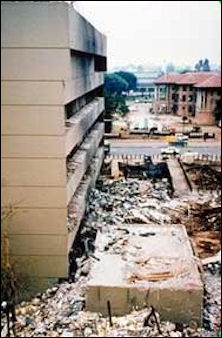
Nairobi bombing On August 7, 1998, near-simultaneous bomb attacks — using truck bombs — against U.S. embassies in Nairobi. Kenya and Dar-es-Salaam, Tanzania killed 224 people, most of them Africans, and injured over 5,000. Twelve Americans were killed.
The Nairobi attack took place just outside the U.S. embassy compound in front of the Ufundi Cooperative Building, which was flattened by the blast and contained most of the dead. The embassy was badly damaged and all the windows in the 25-story Cooperative Bank Building were blown out by the blast. The Dar es Salaam explosion killed nine people and injured about 70. The bomb was planted in a tanker truck that makes regular water deliveries. It exploded within the compound only a few feet from the embassy, severely damaging the southeastern side of the building and leaving a huge crater in the parking lot. It is believed that the bomb was planted without the knowledge of the water truck driver.
The series of events before the explosion in Nairobi went something likes his: 1) a bomb-laden truck showed up at the rear entryway of the embassy compound on Haile Selassie Avenue ; 2) the truck tried to speed through the gate after a mail truck was let out but alert guards quickly closed the gates before the truck could enter; 3) a man jumped from the passenger side of the truck and demanded the guards open the gate. When they refused the man threw a grenade; 4) guards locked the steel gate outside the embassy compound, around the time a second grenade was thrown; 5) the truck bomb exploded in the parking lot outside the compound gate in front of the Ufundi Cooperative building.
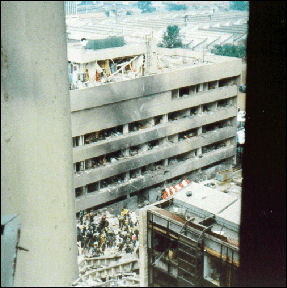
Nairobi Embassy bombing Many of the injured were people who heard the grenade explosions and went to look out the window after the first blast and were struck by shards of flying glass after the second explosion smashed most of the windows within several blocks of the embassy. Many people were blinded and some were horribly mutilated by flying glass.
One 31-year-old bank employee, working near the U.S. Embassy in Nairobi told the New York Times, "I saw things flying all over the place and computers blowing up. We made our way outside. It was horrific. There was a lot of smoke. It was like fog. We couldn't see beyond two feet. Then we saw their blood all over the place." A 23-year-old women who was struck in the face and chest with shards of glass when she looked out window told the New York Times: "There was a loud bang and there was smoke all over. The glass hit me. It shattered all the glass in our building.
A rescue effort was lead by a 120-member Israeli team that used to pneumatic drills, cranes and pickaxes to extract a handful of survivors from the rubble. One Kenyan Parliament member told the New York Times, "There is not a family, not a district in Kenya that is not in someway affected. In my district, 250 kilometers away, we will be burying three victims...The list of the dead — they come from every part of the country."
Planning of the African U.S. Embassy Attacks and Arrests Afterwards
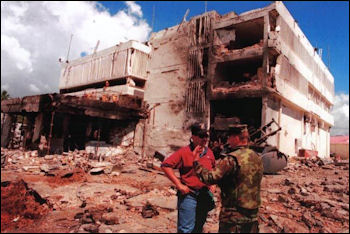
Dar es Salaam bombing Lawrence Wright wrote in The New Yorker: “It is now clear that the bombings had been planned for some time. Zawahiri's man, the double agent Ali Mohamed, testified in New York that bin Laden had asked him to scout American, British, French, and Israeli targets in Nairobi in late 1993. "I took pictures, drew diagrams, and wrote a report," he said. "I later went to Khartoum, where my surveillance files were reviewed by Osama bin Laden . . . and others. Bin Laden looked at the picture of the American Embassy and pointed to where a truck could go as a suicide bomber.” [Source: Lawrence Wright, The New Yorker, September 16, 2002]
“On August 6th, Zawahiri sent the following declaration to a London-based Arabic paper: "We are interested in briefly telling the Americans that their message has been received and that the response, which we hope they will read carefully, is being prepared, because, with God's help, we will write it in the language that they understand." The following day, simultaneous suicide bombings destroyed the American embassies in Kenya and Tanzania.
"American intelligence officials were unprepared for the extent of the devastation in East Africa, and they were amazed by the skill with which the bombings were carried out. The level of planning and coördination indicated that the bombers had a new degree of sophistication, as well as a willingness to raise the stakes in terms of innocent lives. On August 20th, President Clinton ordered an attack on bin Laden's training camps in Afghanistan, and also on a pharmaceutical plant in Sudan that was thought to be manufacturing a precursor to the lethal nerve gas VX — but turned out only to be making medicine.
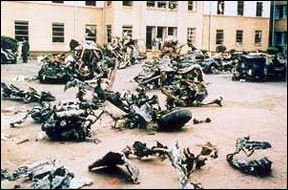
Nairobi bombing About a week after the bombing million dollar rewards were offered for information leading to arrests of the bombers. Several suspects were arrested and taken to the United States. One of the suspect in the bombing, Mohammed Saddiq Odeh, was a conservative Muslim who get really angry when people smoked. He was born in Jordan and worked as fisherman north of Mombasa, where he frequently ventured into Somalia. He lived in Kenya for four years and even obtained a Kenyan passport before the bombing.
In September 2000, a jury in New York found four Al-Qaida members guilty of organizing the attacks in Africa in a trial in which Osama bin Laden himself was indicted on 308 counts for his involvement in the embassy bombings.
U.S.S. Cole Attack in Yemen
On October 12, 2000, a suicide attack on the destroyer USS Cole, one of the most modern ships in the United States' arsenal, killed 17 US Marines and injured 38 in the Yemeni port of Aden. The attack was carried out by an explosives-laden 20-foot-long fiberglass dingy driven by suicide bombers, who rammed the small dingy into the Cole, a 505-foot-long, 8,300-ton ship American destroyer, in waters a few hundred meters from shore in Aden. The dingy and the bombers were reduced to snowflake size pieces.
The Cole cost $1 billion to build and was carrying a 335-member crew and some very advanced weapons and technology, including laser-guided missiles. The ship had stopped in Aden to refuel and “gas and go.” The terrorists waved as they approached the ship and pulled up alongside the Cole. The crew of the Cole believed they were there to help unload trash. When the dingy sat resting next to the Cole’s hull the bomb was detonated.
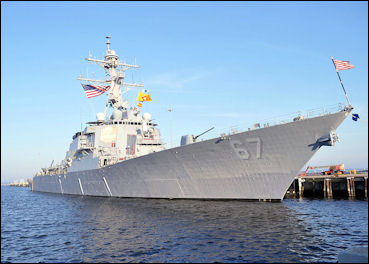
USS Cole There was sympathy in Yemen for the suicide bombers. Yemeni were angry about sanctions on Iraq, where many Yemenis worked, and were angry that the Cole had been involved in enforcing these sanctions. A few months earlier terrorists tried to carry out a similar attack against another U.S. warship that had come refuel in Aden but the terrorist vessel was loaded with so much explosives it sank.
The explosion on the U.S.S. Cole was massive. It blew an a nine-meter-by-12-meter gash in the left side of the ship and tore upwards through a mess area and berthing compartments. Many of the dead had been waiting in line for lunch or eating or working in the kitchen. They were crushed to death as blast drove their deck upward. Many of injured suffered severe leg injured from the explosion beneath them. Others said the ship felt like it had been hit by an earthquake or was riding a “giant wave.” Two Marines escaped by swimming through the hole created by the bomb.
One sailor told the Los Angeles Times the fireball singed his eyes, drove him backwards, sent shrapnel flying into his face and produced a roar that was so load he though his eardrums had exploded, Another said he went “flying like Superman. It was all slow-mo’ weird. I didn’t have time to think.” His head struck the ceiling and a filing cabinet. When he hit the ground a door landed on him and he was doused in fuel.
After the explosion the Cole listed a few degrees to one side and the engine rooms were flooded. The ship came very close to sinking and breaking in half. The explosion released flammable fuel oil throughout the ship and cut off power to the main pumps. Gutsy efforts by the ship’s engineers, who sprayed flame retardant on the oil, kept the ship from exploding. The engineers drilled a hole in the hull to help pump out the water. The blast caused $240 million in damage, Cole was lifted out of the water and carried back to the United States on the deck of a Norwegian ship.
Al-Qaida and the Cole Attack
The Cole attack is widely believed to have been orchestrated by Al-Qaida. An Al-Qaida training video surfaced with boasts of the Cole bombing. Confessions by Al-Qaida members linked other members to the attack. At his son’s wedding in Afghanistan, Osama bin Laden read a poem praising the men who carried out the Cole attack. He called the Cole a ship of “arrogance and haughtiness...sailing to its doom” and called the boat that damaged it a “dinghy bobbing in the waves, disappearing and reappearing in view.” On the dead Americans he said: “The pieces of the bodies of the infidels were flying like dust particles.”
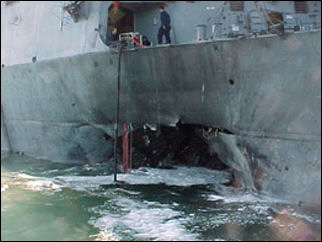
bombing of the USS Cole The Cole attack was similar to the attacks on embassies in Kenya and Tanzania in terms of “plotting, communications and operations.” After the September 11th attack, American investigators uncovered information about Al-Qaida members involved in the Cole attack. The mastermind of the Cole attack, Mohammed Omar al-Harazi, an explosives expert with Al-Qaida, was also is believed to been involved in the attacks on embassies in Kenya and Tanzania
The FBI sent a team to Yemen to investigate the attack. They came up with little to link it to Al-Qaida and left after only a few months after a plot to assassinate them was uncovered. Yemeni investigators were both praised and criticized for their role in the investigation. On one hand they provided the Americans with valuable information. On the other hand, they interfered with the work of American investigators.
The Yemeni government arrested 17 men connection with the Cole bombing, The leader, Jamal al Badawi, helped buy the dingy used in the attack. Most of the suspects were either Yemenis or Saudi-Arabian-born Yemenis who had been trained in Afghanistan. Al Badawi was trained at a Afghanistan Al-Qaida camp and met his conspirators there and worked with Tawfiq Al-Atach, a top security advisor to Osama bin Laden. Al Badawi also said he worked in Yemen with a long-established Al-Qaida cell.
In April 2003, the 10 primary suspects in the Cole attack escaped from a Yemeni prison. They reportedly escaped through a hole in a bathroom wall or a window they broke when they were on their exercise time.
Walid bin Attash, the suspected organizer of the Cole attack, was arrested in Pakistan on April 29, 2003. Abd al-Rahim al Nashiri, a Saudi Arabian national of Yemeni descent held at Guantanamo, was charged with planning and preparing the attack. Nashiri was captured in Dubai in 2002. Prosecutors want the death penalty in his case.
Attack on French Tanker
In October 2002, a French supertanker was struck by an explosives-laden boat in the Gulf of Aden, causing the tanker to spill oil into the sea. Some of the oil caught fire, sending a thick black cloud of smoke into the sky. The attack was similar to that of the Cole except it took place further out at sea. It occurred around the same time as the attack in Bali. One member of the 25-person crew was killed. The other 24 were rescued by helicopter.
The 157,833-ton tanker, the Limburg, was carrying 400,000 barrels of Saudi crude. The explosion left a hole 11 meters high, 8 meters wide and 7 meters below the surfaces. The tanker was crippled but didn’t sink. More than 90,000 barrels f oil leaked into the Gulf of Aden. Most supertankers have small crews and light security. There were worries that similar attacks might be conducted in busy shipping around the Red Sea and Persian Gulf.
Other Terrorist Attacks in Yemen
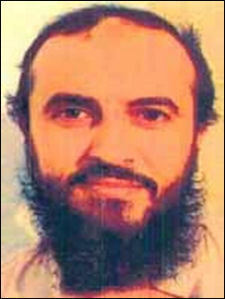
Jamal Mohammad
al-Badawi, mastermind
of the USS Cole attack Terrorists in Yemen have targeted foreigners, and journalists and politicians accused of promoting secularism. An Al-Qaida cell in Yemen was believed to have been behind these attacks. In August 1999, two Yemenis died when a powerful car bomb went off in the embassy area of San’a. A supermarket used by foreigners, the Turkish embassy and the residence of the French ambassador were badly damaged. Around the same time other bombs went off in other parts of Yemen. The bombs went off at night and appeared to be warnings rather than attempts to kill as many people as possible.
In January 2001, a bomb went off at the office of Yemen’s opposition Socialist Party near Aden. The bomb went off when the employees at lunch. There was extensive damages but no one was hurt. The week of the attack five small bombs went off in Aden: at a church, the official news agency, a hotel and two points along a main road. In March 2002, a man hurled at least one grenade at the United States embassy in San’a. There was no damage and no one was hurt or killed.
In December 2002, a gunman killed a prominent secular politician, Jarallah Omar, of the Yemeni Socialist Party, while he was giving a speech condemning the use of violence to achieve political ends. The killers was arrested in the home of the leader of the Islamic Reform Party, the party with the second most seats in parliament. During questioning he said that people like Omar belonged to “secular infidel parties and had to be killed.”
Also in December 2002, a terrorist with a gun wrapped up so it looked like a baby entered a hospital run by Baptist missionaries in Jibla (100 miles from San’a), killing three Americans, the hospital’s director, a doctor and an administrator. A pharmacist took three bullets to the stomach but survived. The hospital had been accused by Islamists of trying to convert people to Christianity.
Image Sources: Wikimedia Commons except Badawi, FBI, and Black Hawk Dowm IMDB
Text Sources: New York Times, Washington Post, Los Angeles Times, Times of London, The Guardian, National Geographic, The New Yorker, Time, Newsweek, Reuters, AP, AFP, Wall Street Journal, The Atlantic Monthly, The Economist, Global Viewpoint (Christian Science Monitor), Foreign Policy, Wikipedia, BBC, CNN, NBC News, Fox News and various books and other publications.
Last updated July 2012
